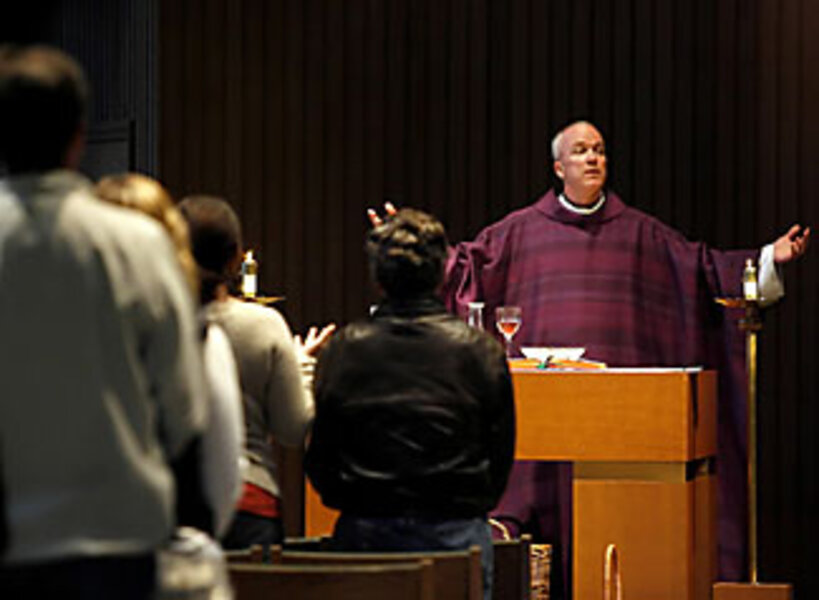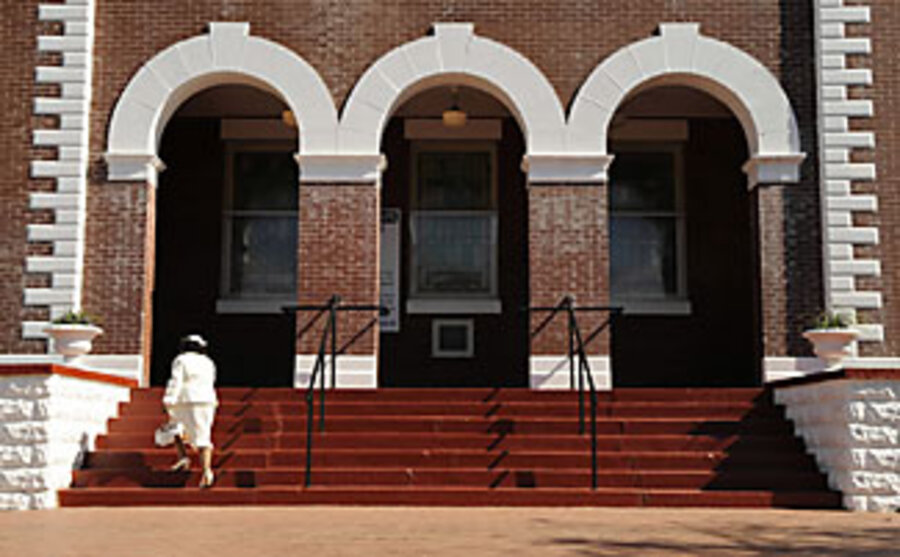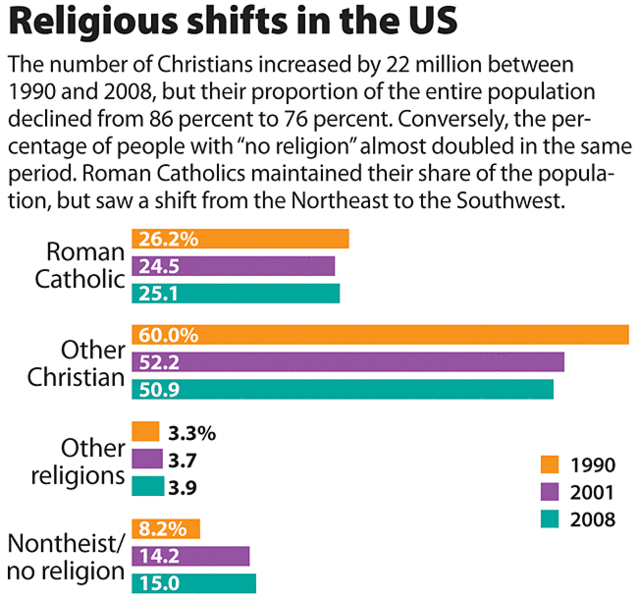Survey sees a drift away from religion in America
Loading...
Christianity's hold on many Americans is slipping, losing out not to other faiths but to "no faith."
Today, 76 percent of the US population call themselves Christians, compared with 86 percent in 1990, according to the third American Religious Self-Identification Survey (ARIS), released Monday by Trinity College in Hartford, Conn. Among Christians, the survey confirms that many are shedding denominational loyalties for a more generic Christian allegiance.
One in every 5 US adults chose not to identify a religious identity: 15 percent chose "no religion" and the other 5 percent declined to name one.
In the traditional Roman Catholic stronghold of New England, for instance, the number of Catholic adherents fell by 1 million between 1990 and 2008, with most of those moving to "no religion." Catholics dropped from 50 percent to 36 percent of the region's population. New York state lost 800,000 Catholics.
"The decline of Catholicism in the Northeast is nothing short of stunning," says Barry Kosmin, a principal investigator for the ARIS surveys of 1990, 2001, and 2008. "There is a correlation between the decline of Catholic identity and the rise of 'the nones,' " as the survey dubs the "no religion" group.
In a major surprise, the Northeast now surpasses the Pacific Northwest as the least religious part of the country. The "nones" represent 34 percent of the population of Vermont, 29 percent in New Hampshire, and 22 percent in Maine and Massachusetts.
Nevertheless, Catholics maintained their one-quarter share of the population, thanks mostly to immigration in the South and West, particularly in California and Texas.
The "no religion" group has gained 20 million adults since 1990 and is the only group to have grown in every state, though at a much slower pace in recent years than in the 1990s. Only 10 percent of that group explicitly identifies as atheist or agnostic.
Denominational drop
During this same 18-year period, the number of Christians rose by 22 million, but their proportion declined. The survey found that most of that growth occurred among those who call themselves either nondenominational Christian, born again or evangelical Christian, or simply "Christian," declining to add a more specific affiliation.
Nondenominational Christians, generally associated with the rise of megachurches, increased from less than 200,000 in 1990 to more than 8 million today. Those opting for generic "Christian" account for 14 percent of the population. "Denominationalism, or Christian brands, have eroded since 1990 – even Protestant doesn't mean anything anymore," says Dr. Kosmin.
The evangelical or born-again label has spread to some Catholics and mainline Christians. "There's a kind of fashion for the term," Kosmin says. No definition was given for the label, but 34 percent of people identify as born again.
Mainline denominations (i.e., Methodist, Presbyterian, Episcopal) showed the greatest losses, declining sharply in numbers and dropping from 18.7 percent of the 1990 population to 12.9 percent today.
"It looks like the two-party system of American Protestantism – mainline versus evangelical – is collapsing," says Mark Silk, director of Trinity's Public Values Program.
As the US population rose by 30 percent between 1990 and 2008, Pentecostals (3.5 percent) and Mormons (1.4 percent) held on to their shares, while some smaller Protestant denominations grew slightly.
Non-Christian faiths recorded the fastest overall rate of growth (50 percent) after the "nones," but represent only 4 percent of Americans. The number of religious Jews (1.2 percent of the population) actually declined by 15 percent, with most of the loss involving young ethnic Jews choosing "no religion."
Buddhism rose to 0.5 percent of the population. The Muslim community doubled in the 1990s, but growth has slowed since; 1.35 million, or 0.6 percent of the population, now identify as Muslim.
New religious movements and groups such as Wiccans are also growing, and account for 1.2 percent of Americans.
Age and gender differences
For the first time, the ARIS 2008 survey included a question on beliefs about God, and the findings suggest some Americans may not share fully the theology of the groups with which they identify.
A little less than 70 percent believe "definitely in a personal God," with 12 percent believing "in a higher power but no personal God." Some 2.3 percent say there is no God, while 10 percent either don't know or don't think there is a way to know.
When asked about religious rituals, 30 percent of married respondents said they were not married in a religious ceremony, and 27 percent of all respondents said they do not expect to have a religious funeral when they die.
With regard to gender, the "no religion" group is the most heavily male (60 percent) among all the groups, while Pentecostals (58 percent) and Baptists (57 percent) have the highest female participation.
Age composition fluctuates considerably within religious groups. Baptists, Jews, and Pentecostals have the highest proportions of those 50 or over (more than half). Muslims and Eastern religions have the youngest, reflecting immigration. Today, 60 percent of Americans are under 50 years of age.
Americans' penchant for switching religions, revealed in a 2008 Religious Landscape Study by Pew Forum on Religion & Public Life, makes it difficult to project trends into the future.
"When people grow up, will they really stay" in their group? Kosmin asks. And now that "a good fraction of the population is being raised outside the religious orbit," what does that mean for religious institutions?
ARIS interviewed 54,461 adults in either English or Spanish for the survey, which has a margin of error of less than 0.5 percent. It can be found at americanreligionsurvey-aris.org.







